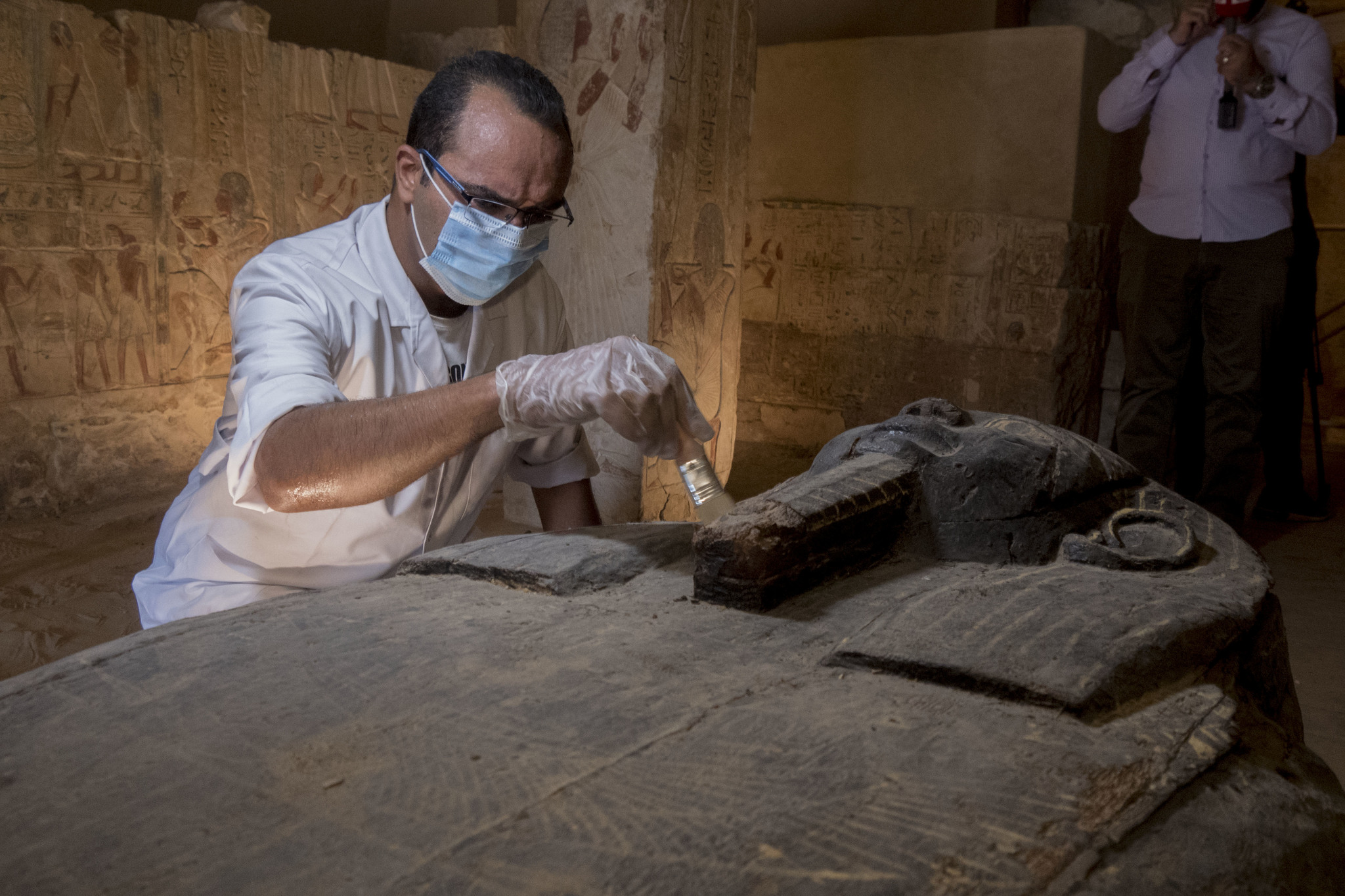In the arid terroir surrounding the stepped pyramid of
Djoser
, where the pyramid fever began, an underground universe is still fighting to make its way into public light.
A skein of vertical shafts, tunnels and passageways that stretches for kilometers and that this Saturday has begun to unravel one of its many mysteries.
The last campaign of excavations has rescued
59 intact graves
from their entrails
.
The treasure of wooden sarcophagi, of different styles, polychromies and sizes, remained safe for the last
2,500
years, oblivious to the voracity of thieves.
"It is a really important find because it is in the shadow of the stepped pyramid, near the tombs of a well-known ambassador who signed the treaty of
Ramses II
with the Hittites, of
Tutankhamun's
nanny
and of a prime minister of Amenhotep III" , has recognized EL MUNDO the mediatic
Zahi Hawass
, former Minister of Antiquities of Egypt, after attending a massive press conference that, marked by the usual fanfare, has served to announce the latest discovery of a necropolis located about 50 kilometers from the current urban agglomeration of
Cairo
.
Under a tent, to mitigate the still hot sun of Egyptian October, the authorities have presented in society 26 of the coffins unearthed by a local mission that began its campaign last August.
"In the area where we located a collection of mummified animals two years ago, we detected access to an 11-meter deep well in which 59 intact sarcophagi had been deposited," detailed Hawass, escorted by the coffins that have just emerged after millennia of rest and that they are the first archaeological announcement since the beginning of the Covid-19 crisis.
The discovery has gradually revealed its enigmas, at the rate that up to three similar wells were inspected.
"First we located 13 intact sarcophagi and then another 14. Last Thursday, when this press conference was already prepared, we found a wooden door behind which another handful of coffins was hidden. We thought about canceling the event but the final order was that there will be time to announce the new details in the coming weeks, "acknowledged
Mustafa al Waziri
, secretary general of the Supreme Council of Antiquities.
"There are layers and layers of sarcophagi," Antiquities Minister Khaled al Anani has launched as a warning.
"They are in a good state of conservation and still retain their original colors," said Al Anani, who has presided over the opening of two coffins before a cascade of cameras and reporters.
After the planned intrigue, two officials have removed the lid and a mummy wrapped in linen and carved with hieroglyphics has broken with two millennia of retirement.
"From what we are reading here, it is about a man called Psamético, a very common name at that time," the minister explained.
A researcher restored one of the mummies found Francisco Carrión
Preliminary examination, which will continue in the laboratory, indicates that the recovered coffins date from the 26th dynasty and belong to a group of priests, high-ranking statesmen, and prominent figures in pharaonic society.
"Its final destination is the Great Egyptian Museum, where it will be exhibited in the room opposite the one dedicated to Al Asasif's hideout, found last year in Luxor and made up of 32 sealed coffins of members of the clergy during the XXII dynasty," he added. Al Anani.
Along with the unfinished procession of sarcophagi, whose identity is still an enigma, the expedition has also dusted 28 statues, mostly of the funerary god
Ptah-Sokar-Osiris
, the chief of Saqqara.
The jewel is, however, a bronze representation of Nefertum, a prominent god of the Egyptian pantheon linked to the birth of the sun.
The 14-inch effigy depicts the deity as a man crowned with a lotus flower made with beautiful inlays of red agate, turquoise, and lapis lazuli.
The pedestal still bears the name of its owner, a certain "Badi Amun", who must also have lived during the XXVI dynasty.
The same wasteland that now recovers part of its buried history gave birth to the mummies of two beetles two years ago, the first on record in ancient Egypt, together with dozens of mummified cats that found burial in the main funerary complex of Memphis , the first capital of Egypt.
"The coffins discovered now will tell us more about mummification and their religious beliefs around
500 BC-
. But this is just the beginning. We have only found 30 percent of what was buried in Saqqara," said Hawass, happy to unravel the skein.
"For an archaeologist, going down a well in search of treasures like these is a passion difficult to describe."
According to the criteria of The Trust Project
Know more
Egypt
science
Archeology Vikings weren't how they were painted: many were neither blond nor Scandinavian
Pandemic found dead penguin after ingesting mask in Brazil
Exploration "The time has come to return to Venus with modern instruments"
See links of interest
News
Translator
Programming
Films
Topics
Holidays Madrid 2021
Confinement Madrid
Stefano Travaglia - Rafael Nadal, live
Khimki Moscow - Panathinaikos
Fenerbahce Istanbul - Red Star
FC Bayern Munich - Olimpia Milan
Atlético de Madrid - Villarreal

